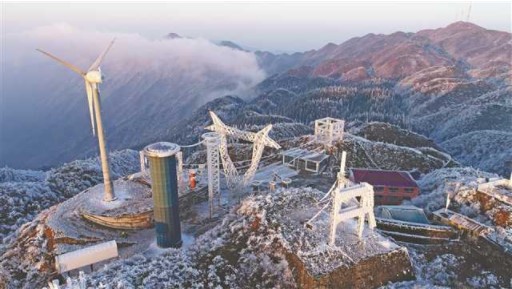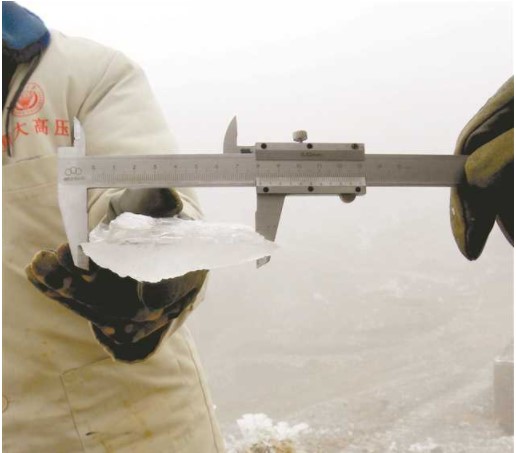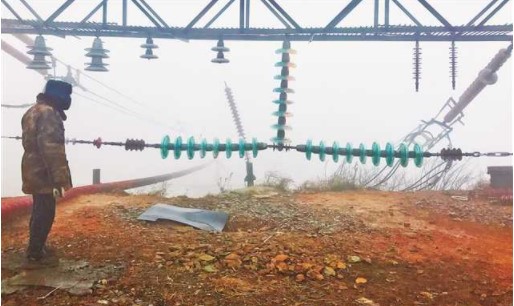
Top view of Field Ice Covering Test Base of Chongqing University

Figure:
Jiang Xingliang, a native of Shaoyang, Hunan, professor of the School of Electrical Engineering, Chongqing University.
Since 1985, Jiang Xingliang has been engaged in the research of power grid ice covering and anti-icing and disaster mitigation in extremely severe environments, and has successively participated in more than 50 major projects such as West-East Power Transmission, Three Gorges Project, Qinghai-Tibet Railway and UHV Project. Jiang has made considerable contributions to the scientific research of
China
.

The glaze poses a varying impact on the power transmission line depending on its size and shape
Photography by Reporter Li Xingting

The seemly beautiful glaze can actually be dangerously disastrous

Conditions of the Test Base with ice covering

Jiang Xingliang is observing the new test results in the dense misty rain. Photography by Reporter Li Xingting

Jiang Xingliang and the workers work in the field about one third of the time a year.
They are crystal and clear and often cling onto grass, woods and stones, like hanging stalactite or swaying wind bells or giant palm-leaf fans… When you get closer to them, you would feel like as if you are situated in a wonderland. But the truth is that a darker power is hidden behind the deceiving beauty that may cause immeasurable disaster. What is it that’s so beautiful and at the same time being so evil? It’s glaze. In winter and early spring, a special type of water drops with temperature lower than 0℃ would form when the cold air flow meets the warm air flow. The water drops would fall from a high altitude to the ground and some of them would freeze on the tree branches, withered grass or power lines and form a crystal and clear ice layer with smooth surface on them. Such water drops are called “ice rain” in meteorological terms and the ice layer is called “glaze” (or “ice”). Glaze is very beautiful and yet it is malicious. It may cause power grid ice covering disasters, which are still puzzling engineers all over the world. How can we solve this worldwide problem? For this purpose, Professor Jiang Xingliang of the School of Electrical Engineering, Chongqing University has built up the first field (natural) ice covering test base (Ice Covering Test Base) in the world at Xuefeng Mountain, Huaihua, Hunan Province, so as to explore and study the law of grid ice covering, and the protection against it and solution to it.
Why is it so difficult to prevent the grid ice covering disaster?
The Pacific warm and wet air flow from the southeast meets the cold air flow of Siberia from the northwest at the narrows of this extended gorge… This is Pingshantang on the Xuefeng Mountain of Huaihua, Hunan and the altitude here is 1,500 meters.
This is where the Field (Natural) Ice Covering Test Base of Chongqing University is located. Standing at the commanding height, you will see how isolated this place is and how it is surrounded by the dense misty rain. Having always worked in the open air, Jiang Xingliang looks more like a building worker. He says that the Xuefeng Mountain that stretches for more than 100 km is the highest mountain in Hunan and the number of days with misty rain here is more than 200 a year and the number of days with thunderstorm is more than 80. The ice covering period is from November to March next year.
the two hilltops in the Base respectively, and the two are both connected to the grid. In addition, there is a wind driven generator of 34 meters high used to supply power for research of fan ice covering and living power consumption of workers at the Base and a giant cylindrical impulse voltage generator… Here, Jiang Xingliang is devoted to grid ice covering, fan ice covering and power transmission in thunderstorm weather. In particular, as for power grid ice covering, the research findings of the team are of the world leading level.
“Grid ice covering laws and the prevention against ice covering are extremely challenging problems that remain to be solved in the world”. Jiang Xingliang says that when ice rain attacks, the seemly beautiful graze may freeze constantly and may overwhelm the power line or poles and towers, which may result in power transmission and communication failure, causing immeasurable loss.
Take a transmission power line with transmission capacity of 1 million kW for example. Assume the power failure lasts 1 hour, there may be direct economic loss of about 500,000 yuan. To build a same transmission line, the cost of each km is 3 million yuan… In the winter of 2008, a continuous and extensive snow and ice disaster attacked south
China
. As a result, 169 counties in Guizhou, Hunan and Jiangxi experienced power outage. The economic loss caused by this disaster topped 100 billion yuan.
“Depending on the size, shape and weight of a specific type of glaze, the tower base, height and cable bearing capacity of the grid design will be different. The formation of glaze is subject to a number of factors and therefore it is highly random. The different types of foreign matters contained in the glaze will result in different conductivities. Therefore, the possibility of flashover trip is hard to predict. This is why it is so difficult to tackle grid ice covering.” Jiang Xingliang adds that international researchers started to study power grid ice covering in 1932. By now, a number of countries such as the
USA
,
Norway
and
Canada
have developed tens of anti-icing and ice removing methods and measures such as laser, hot gas and coating. “However, due to the difficulty in engineering precaution, a lot of difficult science problems remain to be solved.”
Eight years spent on building the Test Station bit by bit
To select a proper location for the test base, Jiang Xingliang visited more than 10 provinces (municipalities and regions) such as Gansu, Guizhou and Yunnan and eventually chose the Xuefeng Mountain of Huaihua, Hunan. “This is because that the weather here is unique and severe and there will be various climatic phenomena such as rime ice, rime snow and glaze, which make it an ideal place for studying natural ice covering of grid.”
During the Chinese New Year Festival of 2018, the reporter of Chongqing Daily, who was on a visit to the base, personally experienced the unpredictable weather of Pingshantang: whether in the day or at night, a fierce gaze may spring up anytime; it may be covered by dense misty rain one minute and the next minute it just clears up.
It is not an easy task to build the ice covering base in the mountain.
“In 2008, Chinese silvergrass spread all over the mountain.” Jiang Xingliang still remembers that in the winter of 2008 when he took more than 10 doctors and postgraduates and some workers to this place, “there was no electric power or water supply.” Zhu Aiguo, who has been working at the base, adds that at the beginning they worked together and built up a work shed of 54 square meters using boards. All teachers, students and workers slept in one wide bed.
No vegetable grows in the mountain. All of them could only feed on instant noodles and pickles, and they had to take water from the hillside with two buckets. On snowy winter night, the freezing cold was unbearable even if they were covered with 3 blankets because the blankets were wet and as cold as ice. What made the situation worse is that the snow water would fall from the clearances of the board above and into the mouth and ears of them…
Held back by the difficult conditions there, no one was willing to work in the mountain. Jiang Xingliang had to lead the students to do excavation, masonry and wiring jobs. “All professors, doctors and students were used as workers in those years. We eventually managed to flatten the hilltop and level up the pits. The flatland we use to carry out test was leveled up by us with soil we borrowed from other places little by little.” Professor Hu Qin of the School of Electrical Engineering, Chongqing University remembers that the more than 1,600 bricks used to construct the pond were carried here by Mr. Hu Jianlin piece by piece; in the summer of 2014, to ensure the glaze tower could be erected in time, they had to work under direct sunshine for 3 days and many of them got serious sunburn…
Eventually, by the year of 2015, the road to the hilltop was built up and opened. The two-storey residential building was also built up. With support from some power enterprises, two glaze towers, impulse voltage generator and other large equipment and testing systems of international standard were successively installed…Bit by bit and stage by stage, Jiang Xingliang and his team built up this first natural ice covering test and research base of the world in 8 years.
The only source of external insulation experiment data for high-voltage transmission in Alpine region in the world
From 2008 to 2018, the team has been observing the power transmission condition in thunderstorm weathers. From October every year to March of the next year, the team would carry out ice covering protection research…Through many years of observation and research, Jiang Xingliang’s team discovered the law of conductor ice covering and melting under ultra-high voltage. Furthermore, they have developed the first power grid ice covering forecasting and warning system in the world, and proposed current-based intelligent ice-melting and de-icing method and obtained internationally leading research achievements.
“The current-based intelligent ice melting involves intelligent control and calculation that allow the current flowing through the power transmission line conductor to remain in a proper range, so as to generate sufficient heat that is enough to melt the ice and snow but is not high enough to burn the conductor.” Jiang Xingliang explains.
By now, the DC ice-melting devices developed based on the theory are widely used in Hunan, Jiangxi and Anhui, and are effectively preventing accidents such as collapse and break of power transmission lines. The research finding was also adopted in major projects such as “West-East Power Transmission” and the safety and reliability of grid power supply have been greatly enhanced. The representative research finding “large-area ice and freeze disaster preventing method and complete equipment switch and their application” has won the national first prize for progress in science and technology of 2013.
The achievements of Jiang Xingliang’s team were not only limited to the research carried out in the Xuefeng Mountain. From 2003 to 2006, the team led by Jiang Xingliang would visit the Qinghai-Tibet Railway 4 times a year to carry out electrical external insulation test of high-altitude high-voltage transmission in Golmud, Lhasa, the Fenghuo Mountain and the Kunlun Mountain Pass with altitudes ranging from 2,800 meters to 5,100 meters.
“The temperature on winter night in the Qinghai-Tibet Plateau is only tens of degrees below zero and the ice layer is more than 1 meter thick. We went out and found sheep manure and combust it to melt the ice, so that we could carry out the related tests. Oxygen deficit is a prominent problem in plateaus so we were not able to work without a stop like when we were in the plain. We had to take rest. In the day, we were able to hang on with an effort. At night, we suffered a lot. We could not fall asleep because our throat would clinch as long as we lay down…” Professor Zhang Zhijing of the School of Electrical Engineering sighs with emotion when he recalls these moments.
Thanks to the experiment data obtained in the depopulated areas, the team acquired the first experiment data on electrical external insulation high-voltage power transmission worldwide. Those are at present still the only experiment data on the external insulation for high-voltage power transmission in Alpine regions in the world.
“We managed to overcome the technical problem with electrical clearance design of tunnels of external insulation of power supply engineering of Qinghai-Tibet Railway, and allowed the free height of the Fenghuoshan Tunnel of Qinghai-Tibet Railway to reduce from 7.2m, as preliminarily designed, to 6.95m. The team helped to save a total of 140 million yuan or so of investment in civil engineering of this tunnel only.” Jiang Xingliang says proudly.
Attack by radioactive power supply causes Jiang severe pains.
Jiang Xingliang has developed a strange habit: He would keep pressing forcefully against his lest waist with hand.
“Since 2005, he has been suffering repeated leg pain. Everyone thought it was rheumatism.” Dong Lina, wife of Jiang Xingliang, says that it was not until the year of 2015 when Jiang Xingliang was finally unable to walk because of the leg pain did he go to the hospital and has a complete checkup. The result showed that Jiang suffered posterior spinal canal schwannoma and the leg pain was caused by the schwannoma pressing against the spinal nerves.
“During the high-voltage electrical insulation discharge test, various radioactive rays and electromagnetic waves will be emitted. In particular, the maximum temperature of the arc core of the final discharge flashover can be as high as 5,000℃, and at the same time, electromagnetic radiation will be generated.” Jiang Xingliang started the grid research in 1985 and more than one third of his time was spent in the field. Due to his dedication to the radioactive power supply related work, his body was deteriorated by the radiations.
In September 2015, Jiang Xingliang underwent the resection operation of spinal canal schwannoma. As the schwannoma was on the thoracic spine nerve sheath, the spinal cord of Jiang Xingliang was injured during the operation. This is why he suffers repeated unbearable waist pain. “My waist aches terribly. I can only press it with hand to distract my attention from the pain.” Jiang Xingliang shrugs.
“The severe pain is causing him tremendous suffering.” Dong Lina says that after the operation, the weight of Jiang Xingliang dropped from 55kg to 45kg. “Many times I woke up in the midnight and saw him knocking his head against the wall to mitigate the pain. I can do nothing but cry…”
Even though, Jiang Xingliang never relinquished the test. “He had to walk with a cane to get to the hilltop, suffering from intolerable pain; 30 days after the operation, Jiang went to the Xuefeng Mountain against the discouragement of the doctor…” Cao Yafeng, a student of Jiang Xingliang who is currently working at the Electric Power Research Institute of Hunan Province, says that every one of the team is inspired by the tenacious spirit of Jiang Xingliang and as a result everyone has been making considerable achievements these years.
Despite the major breakthroughs achieved by the team led by Jiang Xingliang in West-East Power Transmission, ultra-high-voltage power transmission in severe environment and external insulation design and grid anti-icing and disaster mitigation, Jiang Xingliang insists that: “The conditions of grid ice covering prevention are quite complicated. We have to keep exploring new methods. The ice and snow disaster is not exclusive to power grid. It may happen to various areas such as wind power generator, airplane, high-speed railway and highway. In addition, how can we secure regular power transmission in extreme weather conditions like hurricane, debris flow, earthquake and tsunami? These are questions still to be answered.”
“There is no end for scientific research. We have to keep exploring.” Looking at the painting-like Xuefeng Mountain, Jiang Xingliang exclaims: “This is my home.” He says that he hopes to see new breakthroughs and achievements in those areas.
Link to the article:
http://epaper.cqrb.cn/html/cqrb/2018-04/13/016/content_199224.htm
